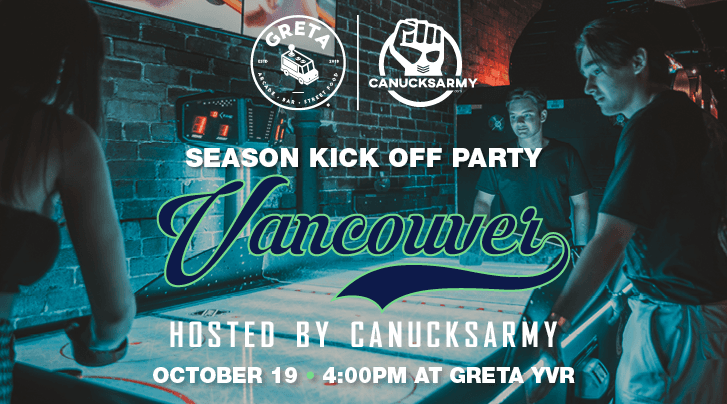Nation Sites
The Nation Network
CanucksArmy has no direct affiliation to the Vancouver Canucks, Canucks Sports & Entertainment, NHL, or NHLPA
Canucks: How body positioning and puck tracking improvements can fix Arturs Silovs’ long shot problem

Photo credit: © Bob Frid-Imagn Images
Oct 11, 2024, 13:00 EDTUpdated: Oct 11, 2024, 13:29 EDT
In a career that’s only 20 games old, Arturs Silovs has already experienced some of the biggest highs an NHL goaltender can. But now he’s going through the first real test that nearly every netminder faces at the highest level; what happens when opponents figure out your Achilles’ heel.
As the Canucks’ playoff run wound down back in May, the Edmonton Oilers had noticably begun to spam a particular kind of scoring attempt against Silovs with a shockingly high degree of success: long shots from the point. In Game 7, that game plan was all the more noticeable, as Cody Ceci and Evan Bouchard both scored from distance in the series clincher.
Now through the preseason and the first game of the regular season, teams like the Calgary Flames have been following the Oilers’ playbook, and it’s working far too well. Two shots from above the circles in the third period on Wednesday beat Silovs and worked to set up the Canucks’ heart-breaking collapse in overtime.
Silovs’ struggles tracking shots are costing him and the Canucks with increasing frequency, as teams learn more from every additional roll of game tape. And for a 23-year-old with limited NHL experience, that kind of knowledge can unravel a young goalie’s confidence. Especially when it’s heaped on top of the existing pressure to replace a Vezina finalist in Thatcher Demko for an unknown amount of time.
Nipping things in the bud is certainly harder when you’re playing a starter’s schedule, but sadly that’s the only option for Silovs right now and solutions are needed fast. So what’s the sticking point?
The most common way for a goalie to struggle with stopping long shots is by losing their positioning between the puck and the net. If you’ve been attending In The Crease Academy reguarly over the last three years, you’ll remember Rule #1: square up to the puck, not the shooter. And when there’s a sea of bodies, sticks and skates blocking your view, it gets harder to position yourself that accurately.
That’s why you also have to act quickly to maintain a clear view of the puck. The best ways to accomplish that while not losing your positioning is by either leaning around the screen or looking over them, crucially without moving your feet and taking yourself out of position.
Let’s look at Evan Bouchard’s goal from Game 7.
Here, we see a couple of errors compound into a goal. At first, Silovs is square to the puck, making a micro adjustment as Bouchard drifts back towards the boards. As Zach Hyman parks himself in front of the net and Pius Suter tries to block a deflection, Silovs loses sight of the puck long enough to briefly look over the two skaters in front of him. Not liking his view, Silovs shifts farther left to lean around Hyman, but he puts himself out of position in the process right as Bouchard lets the shot go for the right-hand corner.
With a little more patience in the taller stance, Silovs might’ve picked up on Bouchard shifting his shot back towards the middle of the ice and been in a better position to stop the puck.
Now, how about Cody Ceci’s goal from earlier in that game?
In this scenario, Silovs is in the right position and, outside of a very high screen in Nils Åman, has a pretty clear view of the shooter and the puck. This is where we get into another key element: hand positioning.
Where you position your blocker and glove changes depending on the scoring chance. But the one consistency is that your hands need to be out in front of your body, covering more net and giving you more control over where you place them. In this case, Silovs has his glove hand off to the side right up until the moment Ceci shoots the puck.
As soon as he notices a shot is coming, Silovs’ initial instinct is to drop his hands down above his pads, covering the lower part of the net. But he realizes the puck is sailing high a millisecond too late, and only has time to throw up a chicken wing arm as the shot passes him.
Rasmus Andersson beat Silovs in a similar fashion in Wednesday night’s tilt with Calgary. Here Silovs brought his glove hand to his side as he shifted across the net, and Andersson found the extra space up high. If he can remember to keep his hands in front of him more forcefully, he’ll end up in the right position more often and limit the amount of times he has to alter course mid-shot.
One other adjustment that the Canucks might want to make with Silovs is to encourage him to challenge out farther when he has a clear lane. Under Ian Clark’s tutelage, (and Rollie Melanson’s before him) Canucks goalies have been encouraged to play deeper in their net and make smaller movements to cover the net. This style of play works great for big, structurally sound goalies like the ones the Canucks have made a habit of drafting and developing.
But while Silovs does fall squarely into that category, his best weapons has routinely been his athleticism and speed, traits more in line with a smaller goalie’s playing style. That opens up one other way for Silovs to better protect the net from point shots; by challenging out of the paint entirely, Silovs could effectively cover more of the shooting lane, create less room for a screen and still be able to recover back to his net in the event of a rebound.
The good news about all of this is that Silovs is dealing with are simply mechanical issues. When it comes to the harder-to-teach skills like keeping up with NHL pace and shooters, Silovs already has those talents down. And that’s what separates him from the usual journeyman backup the Canucks have had filling in for Demko in seasons past. All he needs to improve on are positioning adjustments, things that can be easily worked on in any on-ice or off-ice training.
It won’t be an overnight change, but with time and practice Silovs should be more than capable of shutting down the point shot problem and clearing the first major hurdle towards a long and fruitful career.
CanucksArmy! The season is HERE, and what better way to kick it off than with your crew at Greta? It’s all going down on Saturday, October 19th at CanucksArmy’s home for the fans, Greta Bar! We’ve got it all—prizes, trivia, and more to keep the energy buzzing all night. And this time, we’re doing it for a great cause, supporting the BC Mental Health Foundation. Doors open at 3PM, and you know the drill—tickets are going fast, so hit up nationgear.ca before they’re gone. This event is 19+.
Recent articles from Lachlan Irvine
Breaking News
- Quinn Hughes talks thought process in lead-up and aftermath of trade from Canucks to Wild
- Wagner’s Weekly: After Hughes trade, which Canuck will get traded next?
- The Stanchies: Zeev Buium’s two point debut leads the way in Canucks’ 2-1 victory over Devils
- Canucks forward Lukas Reichel clears waivers
- Instant Reaction: Zeev Buium scores game-winning goal in Canucks debut vs. Devils

